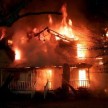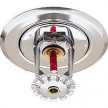Home Fire Sprinkler Facts
 How much do you know about home fire sprinkler systems?
How much do you know about home fire sprinkler systems?
If you’re reading this at work, chances are pretty good there is a fire sprinkler in the ceiling over your head. That’s because automatic fire sprinkler technology has been protecting industrial, commercial and high-rise properties since the late 1800s. But did you know that same technology can also protect you at home?
Over the past 25 years or so, more and more homes are being protected by sprinkler systems every year, making the places we’re at greatest risk from fire much safer.
That’s critically important because nine out of 10 civilian structure fire deaths happen at home. According to the National Fire Protection Association (NFPA), in 2009 a home fire was reported every 87 minutes. Those fires injured more than 12,500 people and killed 2,565.
Design improvements and lower installation costs have made home fire sprinklers more desirable. Today, savvy home-buyers want a sprinklered home because it provides peace of mind, especially for more vulnerable family members such as young children and older adults.
Yet, there is some confusion about sprinklers. Here are the facts from the nonprofit Home Fire Sprinkler Coalition (HFSC), a non-commercial educational organization:
How sprinklers work: A network of piping hidden behind walls and ceilings feeds the sprinklers. If a fire starts, the sprinkler closest to it will activate while the fire is still small, controlling or extinguishing it.
How sprinklers save lives: A fire grows rapidly and spreads toxic, super-heated smoke. Left unchecked, it can reach flashover in three minutes or less. The sprinkler’s quick reaction to the fire controls deadly heat and smoke, giving occupants time to escape and preventing flash-over.
Myth busting: Only the high heat of a fire can cause a sprinkler to activate – not burned toast, or a smoke alarm. The fire sprinklers work individually. Even though you’ve seen movies where all the sprinklers flow water at once, that doesn’t happen in real life. In 90% of sprinklered home fires, only one sprinkler was needed to control the blaze. There is less water damage with a fire sprinkler, which flows 25 gallons of water per minute, compared to 250 gallons of water per minute from high-pressure fire hoses.








